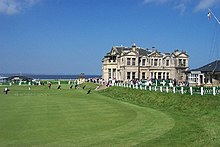Old Course

R&A Clubhouse and 18th green in 2004
|
|
| Club information | |
|---|---|
| Coordinates | 56°20′35″N 2°48′11″W / 56.343°N 2.803°WCoordinates: 56°20′35″N 2°48′11″W / 56.343°N 2.803°W |
| Location | St Andrews, Scotland |
| Established | 1552 |
| Type | Public |
| Owned by | Fife Council |
| Operated by | St Andrews Links Trust |
| Total holes | 18 |
| Tournaments hosted | The Open Championship, Alfred Dunhill Links Championship |
| Website | Old Course |
| Par | 72 |
| Length |
6,721 yards (6,146 m) Longest hole is #14 – Long, 6,146 yards (5,620 m) |
| Course record | 62; Victor Dubuisson, George Coetzee (2012),Paul Casey (2013), Tommy Fleetwood, Louis Oosthuizen (2014), Tyrrell Hatton (2016) |
6,721 yards (6,146 m)
The Old Course at St Andrews is one of the oldest golf courses in the world, a public course over common land in St Andrews, Fife, Scotland. It is held in trust by The St Andrews Links Trust under an act of Parliament. The Royal and Ancient Golf Club of St Andrews club house sits adjacent to the first tee, although it is but one of many clubs that have playing privileges on the course, along with the general public.
The Old Course at St Andrews is considered by many to be the "home of golf" because the sport was first played on the Links at St Andrews in the early 15th century. Golf was becoming increasingly popular in Scotland until in 1457, when James II of Scotland banned golf because he felt that young men were playing too much golf instead of practicing their archery. The ban was upheld by the following kings of Scotland until 1502, when King James IV became a golfer himself and removed the ban.
In 1552, Archbishop John Hamilton gave the town people of St. Andrews the right to play on the links. In 1754, 22 noblemen, professors, and landowners founded the Society of St Andrews Golfers. This society would eventually become the precursor to the Royal and Ancient which is the governing body for golf everywhere outside of the United States and Mexico. St Andrews Links had a scare when they went bankrupt in 1797. The Town Council of St. Andrews decided to allow rabbit farming on the golf course to challenge golf for popularity. Twenty years of legal battling between the golfers and rabbit farmers ended in 1821 when a local landowner and golfer named James Cheape of Strathtyrum bought the land and is credited with saving the links for golf. The course evolved without the help of any one architect for many years, though notable contributions to its design were made by Daw Anderson in the 1850s and Old Tom Morris (1865–1908), who designed the 1st and 18th holes. Originally, it was played over the same set of fairways out and back to the same holes. As interest in the game increased, groups of golfers would often be playing the same hole, but going in different directions.
...
Wikipedia
